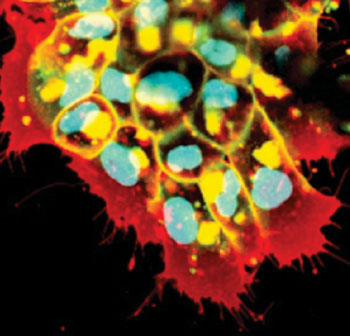Blocking Cell Movement Explored to Stop the Spread of Cancer
By LabMedica International staff writers
Posted on 15 Jul 2014
Learning more about how cells travel through the body could lead to innovative new treatments to block cancer cells from metastasizing and causing secondary tumors, according to new research.Posted on 15 Jul 2014
Scientists discovered that cells can change into an invasive, liquid-like state to readily move through the thin channels in the human body. This transformation is activated by chemical signals, which could be blocked to stop cancer cells from spreading. Most cancer deaths are not caused by to primary tumors, but to secondary tumors in major organs, such as the lungs or brain, caused by cells moving from the original tumor to other places in the body.

Image: Migrating embryonic neural crest cells (Photo courtesy of UCL - University College London).
The study led by the University College London (UCL; UK) researchers and published July 8, 2014, in the Journal of Cell Biology, used embryonic cells to better determine how groups of cells move in a developmental process similar to that exploited by cancer to spread around the body. The scientists reported that a molecule called lysophosphatidic acid (LPA) transforms cells from a solid-like to a liquid-like state, allowing cells to flow between normal tissues in the body. They were able to turn off the signals from LPA, stopping the cells from moving down the narrow, blood vessel-like channels.
Lead scientist Prof. Roberto Mayor, from the UCL department of cell and developmental biology, said, “We have found a way to stop the movement of embryonic cells by blocking LPA signals. It is likely that a similar mechanism operates during cancer invasion, which suggests a possible alternative which cancer treatments might work in the future, if therapies can be targeted to limit the tissue fluidity of tumors. Our findings are important for the fields of cell, developmental and cancer biology. Previously, we thought cells only moved around the body either individually or as groups of well-connected cells. What we have discovered is a hybrid state where cells loosen their links to neighboring cells but still move en masse together, like a liquid. Moreover, we can stop this movement.”
Related Links:
University College London









 assay.jpg)




